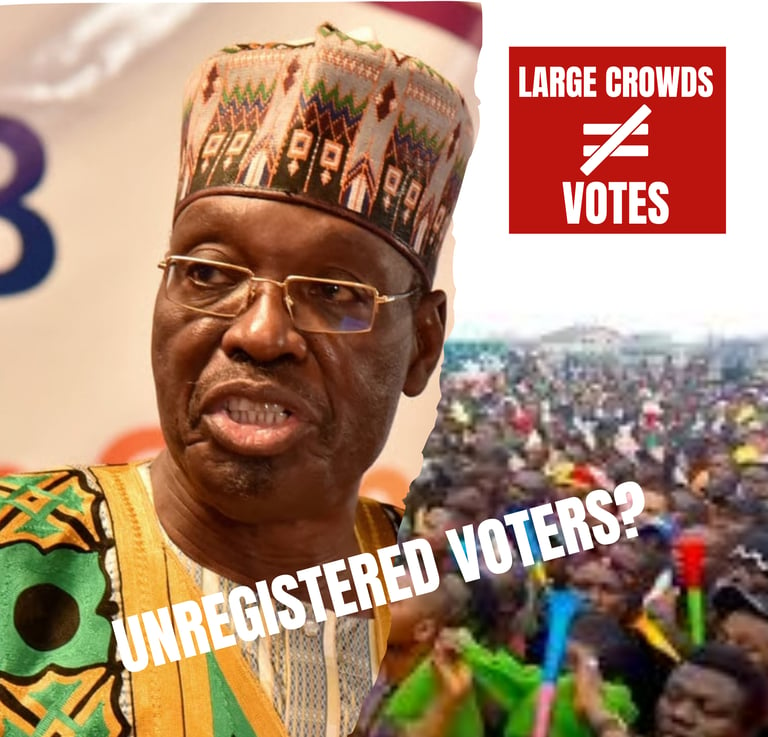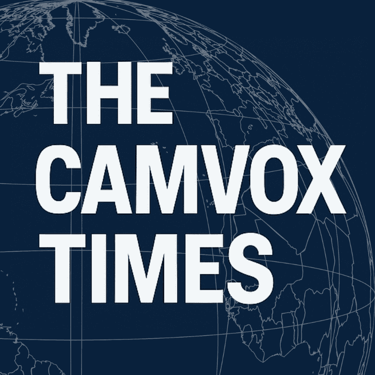Noise Without Numbers:
Why Issa Tchiroma’s Campaign Crowds Won’t Translate into Votes
OCTOBER 2025
Dr. Julius Babila Taka, PhD, Chairman, CPDM USA Campaign Task Force (Communications Subcommittee)
10/11/20254 min read


The Drumbeat and the Ballot
In Cameroon’s charged political season, democracy is once again dancing to two competing rhythms—the drumbeat of noise and the heartbeat of numbers.
At Issa Tchiroma Bakary’s campaign rallies, the drumbeat is deafening: tambourines clash, whistles shriek, and crowds swirl in ecstatic defiance. Yet behind the spectacle lies a quieter truth—most of those cheering lack the one instrument that matters on election day: the voter’s card.
During a CPDM door-to-door campaign in Yaoundé III earlier this year, an elderly woman, Maman Rosine, lifted her voter card as if it were a relic of faith. “I dance for Biya not because of the music,” she said, “but because my name is on the register. My dancing ends in the ballot box.”
Across town that same week, a young man at a Tchiroma rally waved a poster while dancing atop a truck. When asked whether he was registered, he laughed. “No, I lost my ID long ago. I’ll register next time.”
Between Maman Rosine’s certainty and the young man’s hesitation lies the gulf separating symbolic participation from effective participation—the difference between noise and numbers.
Optics vs. Organization
Crowds have always seduced politicians. They create the illusion of unanimity, a mirage of momentum. But as political sociologists remind us, enthusiasm without organization is rainfall on marble—it dazzles, then disappears.
Tchiroma’s gatherings resemble carnivals more than campaigns. Many attend for the music, not the message. “I follow the drums wherever they go,” said Aisha, a fruit vendor from Garoua. “I don’t even know where my polling station is.”
The CPDM, by contrast, turns turnout into structure. Each militant is mapped within a local subsection, every name tied to a registration list, every vote accounted for. A CPDM rally is not an audience—it’s an operational network. Behind the cheers is a database; behind the loyalty, a logistics plan.
It’s the same principle that powered Barack Obama’s 2008 “ground game,” where excitement became data. President Paul Biya’s CPDM applies the same discipline: loyalty becomes ballots. Tchiroma’s campaign, meanwhile, floats on optics without ownership.
The Science of Electoral Conversion
Decades ago, scholars at Columbia University showed that personal influence—not public spectacle—drives electoral outcomes. Campaigns without organizational roots sprout quickly and die just as fast.
In Kenya’s 2013 election, Raila Odinga’s crowds dwarfed those of Uhuru Kenyatta, yet Kenyatta’s quieter mapping of every voter won the day. In Gabon 2016, Jean Ping’s euphoric rallies outshouted Ali Bongo’s—but on election night, Bongo’s machine prevailed.
Tchiroma’s strategy echoes those patterns: visibility mistaken for viability, applause for advantage. “He speaks for us,” a student at his Douala rally admitted, “but we cannot yet vote for him.” Passion without registration is political vapor—rising fast, vanishing faster.
Institutional Strength: The CPDM Advantage
Institutions are democracy’s arteries. Over four decades, the CPDM has refined a mobilization model linking chiefs, clergy, and community heads in an unbroken chain of political continuity.
“In our village, the CPDM is not an event—it is a structure,” said Fon Ngu Peter during a campaign stop in Mbengwi. “We vote not in excitement but in continuity.”
By contrast, Tchiroma’s movement is a burst of emotion unsupported by infrastructure. When the music fades, no apparatus remains to remind, mobilize, or transport his crowd to polling stations.
History is full of parallels. In France 2017, Jean-Luc Mélenchon’s massive rallies in Marseille electrified crowds but lacked the logistics of Emmanuel Macron’s En Marche. Mélenchon’s volume was louder; Macron’s numbers, stronger.
Timing, Law, and the Closed Register
Politics rewards foresight. When ELECAM closed voter registration on June 30, Issa Tchiroma’s July resignation came too late. His newfound independence stirred emotions—but the gate was already shut.
The CPDM, meanwhile, had spent months conducting registration caravans and verification drives, ensuring every supporter’s name was on the roll before the season began. The difference was preparation.
Like a farmer who begins plowing in the dry season, Tchiroma had soil and tools—but no rain.
The Rational Voter Equation
Economist Anthony Downs argued that voters act when benefits outweigh costs. CPDM voters perceive Biya’s continuity as the rational choice: schools open, pensions paid, peace maintained. Tchiroma’s supporters, by contrast, exhibit what behavioral economists call a participation deficit—the emotional satisfaction of protest without procedural engagement.
In Brazil 2018, Jair Bolsonaro’s supporters registered en masse online, while Ciro Gomes’ youthful crowds abstained. The result was inevitable.
“I shout for change,” confessed Joseph, a carpenter at a Bamenda rally, “but I have never voted. I don’t even have an ID.”
Passion without paperwork remains powerless.
Optical Illusions in the Age of Social Media
In today’s digital politics, a single drone shot can fabricate a movement. Algorithms reward spectacle, not substance. Tchiroma’s team has mastered this illusion—tight camera angles, dramatic captions, inflated numbers—but digital virality does not equate to electoral validity.
The pattern is global. In Nigeria 2023, Peter Obi’s stunning visuals failed to beat Tinubu’s quiet, data-driven network. In the United States 2020, Trump’s packed arenas could not outweigh Biden’s smaller, surgically targeted voter turnout.
Social media simulates democracy; institutions sustain it. The CPDM understands this. Every “like” is linked to a registered supporter—an algorithm matched to an elector.
Forecast and Statistical Outlook
Using the CPDM USA Campaign Task Force Electoral Forecast Model—which analyzes registration density, polling accessibility, and rural-urban dispersion—President Paul Biya’s projected vote share ranges between 68 and 71 percent.
The data follow a historic pattern:
2004 — 70.9 % (Biya)
2011 — 77.9 % (Biya)
2018 — 71.3 % (Biya)
Stable governance and verified registration consistently yield majorities in societies that value continuity over risk. Tchiroma’s rallies may dominate WhatsApp threads, but not ELECAM spreadsheets. His estimated voter-to-attendee ratio remains below 10 percent—a hallmark of populist campaigns that resonate loudly but count lightly.
Global Echoes of Failure and Faith
History’s ledger is filled with movements of great noise but little consequence:
Bernie Sanders (USA 2016 & 2020): Overflowing rallies; under-registered youth.
Bobi Wine (Uganda 2021): Electrified urban centers; lacked rural mobilization.
Jeremy Corbyn (UK 2019): Stadium crowds; suburban abstention.
Each proved the same law: charisma ignites sparks, but organization conducts current.
The Mathematics of Democracy
On October 12, 2025, the true contest will unfold not under stadium lights but inside quiet polling stations—where registered fingers meet biometric scanners.
Issa Tchiroma’s campaign may echo like thunder, but as the African proverb reminds us, “Thunder makes noise; rain brings growth.”
President Paul Biya’s CPDM is the rain—steady, measurable, life-giving. Because in democracy, it is not the loudest drum that wins the dance; it is the drummer who keeps time.
Tchiroma’s campaign has the noise.
Biya’s campaign has the numbers.
And numbers—not noise—make presidents.
